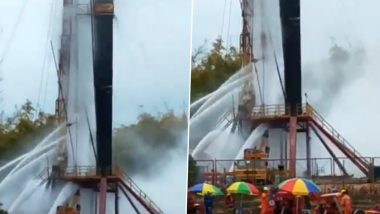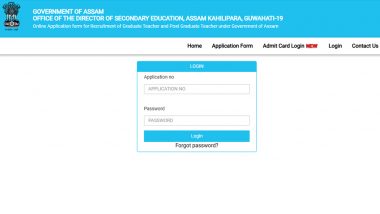Tinsukia, June 8: Following a blowout in a natural gas well in Assam's Tinsukia district, oil has been continuously leaking since May 27. In a bid to control the blowout in the gas well, a three-member expert team from a Singapore-based emergency management firm Alert Disaster Control has been roped in. More than 2500 people from surrounding villages have been evacuated. Due to the natural gas leak, a variety of fish and endangered Gangetic dolphins are feared dead. OIL Appoints Consultant to Study Environmental Impact of Gas Well Blowout in Assam.
Where is the gas well? What is a blowout?
The blowout took place at the gad well at the Baghjan village in eastern Assam's Tinsukia district. This is purely a gas-producing well. The state-owned Oil India Ltd (OIL) has been drilling out natural gas from here since 2006. It produces around 80,000 standard cubic metres per day (SCMD) of gas from a depth of 3,870 metres. A blowout means a sudden and uncontrolled release of gas/oil. To control a blowout, the first step is to pump in water, so that the gas does not catch fire. Mumbai Gas Leak: Reason of Foul Smell Yet to be Ascertained, Source of Leakage Not Found, Says Fire Brigade.
What is being done to mitigate the impact of the blowout?
Authorities have created a barricade around the Baghjan gas well site to prevent the contaminated water runoff to surrounding and nearby water bodies. According to an official release, 650 families, comprising 2,500 people, have been shifted to three relief camps. OIL will pay Rs 30,000 as immediate relief to each impacted family. A five-member inquiry committee has been formed to ascertain if there is any prima facie evidence of human error.
The OIL has issued a show-cause notice to M/s John Energy Pvt Ltd and assured action its employees if found guilty of negligence. To minimise chances of fire, OIL has places water pumps in the nearby river and pipeline laying jobs were in progress for additional high quantities of water.
Blowout fallout:
A variety of fish, Gangetic dolphins, birds and domestic cattle have died so far due to the leak in the natural gas well. Recently, locals found a carcass of a Gangetic dolphin. Over 45 environmentalists, academics, wildlife experts, writers, social activists and journalists have expressed concern over the environmental consequences of the blowout near the Dibru-Saikhowa National Park, a biodiversity hotspot.
In a statement, they said the Baghjan oilfield was located next to the Maguri-Motapung wetland, part of the eco-sensitive zone of the Dibru-Saikhowa National Park, known for migratory birds and feral horses. The villagers of this area were dependent upon the wetland and the Dangori and Dibru rivers in the Baghjan area for livelihood.
(The above story first appeared on LatestLY on Jun 08, 2020 10:32 AM IST. For more news and updates on politics, world, sports, entertainment and lifestyle, log on to our website latestly.com).












 Quickly
Quickly




















